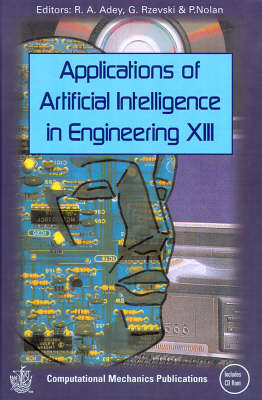
Applications of Artificial Intelligence in Engineering
WIT Press (Verlag)
978-1-85312-596-6 (ISBN)
The Applications of Artificial Intellegence in Engineering (AIEng) conferences have consistently provided an important forum for the discussion of realistic AI applications. They have tracked the maturing of AI from its early days of tremendous (if over hyped) promise, through a period of less favourable press when some unrealistic expectations were unfulfilled, to the present when many of AI's underlying technologies, including fuzzy logic and neural networks, are firmly established within engineering. This book contains the extended abstracts of the papers presented at the thirteenth International Conference on the Application of Artificial Intellegence in Engineering, held at the National University of Ireland, Galway (NUIG) in July 1998. The papers represent the work of AI researchers from around the world and cover all the main branches of engineering including civil and environmental engineering, hydrology, architecture, manufacturing and process engineering, and control engineering. Amongst the techniques reviewed are neural networks, fuzzy logic, genetic algorithms, machine learning, distributed intelligence and rule-based systems.
SECTION 1: AI IN CIVIL ENGINEERING AND ARCHITECTURE A unified approach for complex problem solving: Method integration; Integrated prediction support tool for water tide predictions; Integrated building design decision support with fuzzy logic; Usability of intelligent agent systems in urban traffic control; Knowledge-based generation of the assembly order of elements in wooden construction; The use of expert systems, hypertext and spreadsheets in construction. SECTION 2: DESIGN Applying AI to preliminary design of buildings; Optimum design with intelligent control of a log manipulator; Genetic graph drawing; Producing designs of physical systems through model transmutations; Performance tests on several parametric representations for an Arabic phoneme recognition system using HMMs; Towards a graphical and real-time network simulation toolset; Automatic configuration of chromosomes for genetic algorithm - based optimization in well-defined design problems; A search method in knowledge-based systems using euclidean spacenorm - An application to design of robot grippers; Assessing the sustainability of projects: A fuzzy approach; An integrated framework for the specification and design of reprographic machines; Design of retaining walls: System uncertainty & fuzzy safety measures; Application of neural network in modelling of relationships between hardenability and chemical composition of the constructional alloy steels; Application of artificial neural networks for internal combustion engine thermal cycle analyze. SECTION 3: ENVIRONMENTAL ENGINEERING Further study of control system for reservoir operation aided by neutral networks and fuzzy set theory; Genetic algorithm encoding probabilities & population size. SECTION 4: PROCESS CONTROL Multi-agent systems for modelling of self-organization and cooperation processes; SPARSE - a prolog based application for the portuguese transmission network: Some important aspects for practical use; A novel firing rule for training Kohonen self-organising maps; Recent advances in intelligent inspection of wood boards; 3D motion decomposition and linear estimation in the presence of spatial uncertainties; Development of an intelligent alarm processor for electric power plants. SECTION 5: AI TOOLS Chaotic prediction of rainfall with radar data and neural network; A feed-forward neural network approach to edge detection; Web-based delivery of AI/expert system courses in engineering education; A fuzzy recurrent neural network of binary neurons for content addressable memory; A rule-base result analyst tool for simulation models of computer systems; On the automatic synthesis of functional dependency graphs from libraries of component models; A general problem solving system for engineering; An architecture for knowledge discovery in complex telecommunication systems; An artificial neural network approach to software testing effort estimation; Cellular automata show the way to safer engineering decisions; Applying SQL techniques on inference mechanisms of expert systems; Techniques for distributed intelligence and internet connectivity on home automation networks. SECTION 6: FAULT DIAGNOSIS Towards guiding fault diagnosis based on experience; Hierarchically structured inductive learning for fault diagnosis; Fault diagnosis using a decision tree of simple modular neural networks. SECTION 7: MANUFACTURING Knowledge acquisition for production system design by mapping distinct conceptual knowledge pools; A fuzzy cognitive map based intelligent system for reengineering manufacturing systems; A knowledge-based system (KBS) to improve bore geometry.
| Reihe/Serie | Software Studies. ; v. 1. |
|---|---|
| Verlagsort | Southampton |
| Sprache | englisch |
| Maße | 155 x 230 mm |
| Themenwelt | Informatik ► Theorie / Studium ► Künstliche Intelligenz / Robotik |
| Informatik ► Weitere Themen ► CAD-Programme | |
| Technik ► Maschinenbau | |
| ISBN-10 | 1-85312-596-2 / 1853125962 |
| ISBN-13 | 978-1-85312-596-6 / 9781853125966 |
| Zustand | Neuware |
| Informationen gemäß Produktsicherheitsverordnung (GPSR) | |
| Haben Sie eine Frage zum Produkt? |
aus dem Bereich


